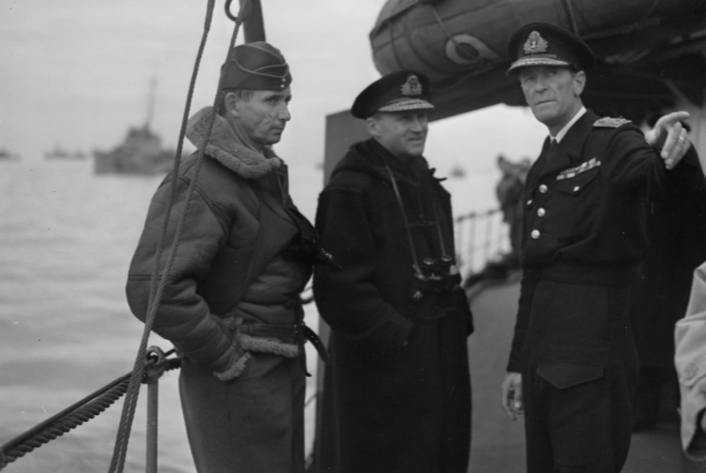The Man Who Planned D-Day

Ask most sailors to name the Royal Navy’s greatest 20th century commander and names such as Cunningham, Fraser, Keyes, Beatty, maybe Pound or Chatfield might be offered.
Admiral Sir Betram Ramsay, who died on January 2, 1945, was a leader more in the Eisenhower vein: a supreme organizer rather than a seagoing commander, directing operations from a headquarters rather than an admiral’s bridge, and the man behind not one but two of the greatest naval operations ever mounted.
A quiet, modest figure, demanding of his staff and himself, he bore tremendous burden stoically, invariably confiding only in his wife. Thoroughness was his trademark – as was his willingness to delegate to the junior officers around him, a characteristic which led to a pre-war clash with the old guard in the Admiralty.
That clash led to his resignation as Chief-of-Staff to the Commander-in-Chief of the Home Fleet – a move which would have ended his career, had not war engulfed Europe. Assigned the post of Vice Admiral, Dover, fate would see to it that he was thrust into the crucible of war in May and June 1940.
Ramsay’s diligence and ability to delegate were key to the improvised evacuation of the British Expeditionary Force from the Continent. Despite the severe strain which the ten days of Dunkirk placed on Ramsay – the operation stretched “everyone to the limit,” he wrote to his wife – the results of the evacuation were “beyond belief”, thanks largely to the Navy running like “a perfect machine.”
Operation Dynamo earned Ramsay plaudits from ordinary soldiers, colonels and generals, and George VI, who knighted him three days after the evacuation ended.
He would go on to be the architect of the amphibious landings in North Africa (Operation Torch), Sicily (Operation Husky) and finally Normandy (Operation Neptune, the D-Day landings).

Adm. Ramsay (center) with the RAF's Sir Arthur Tedder (left) and Rear Adm. Sir Phillip Vian (right) (Royal Navy)
The image of ‘Ramsay the staff officer’ rather obscures ‘Ramsay the sailor’. For much of his career, he was a seagoing officer. He served in the first commission of the revolutionary Dreadnought, commanded the cruisers Weymouth and Kent and the ‘Tiddly Quid’, battleship HMS Royal Sovereign.
Ramsay’s formative years in command, however, came with the Dover Patrol – protecting the passage of men and material to France and preventing German forces slipping through the Channel on or below the surface.
After commanding the floating gun platform HMS M25, a monitor used to pummel the German lines, in late 1917 he was appointed commanding officer of the legendary destroyer HMS Broke which had charged at the High Seas Fleet at Jutland and subsequently careered out of control.

HMS Broke (Illustrated London News / R. Perkins / Crown copyright)
In the second week of May 1918, Broke was one of eight destroyers assigned to a daring – and often overlooked – raid to keep German submarines bottled up in their Flanders base.
The Zeebrugge Raid on St George’s Day had partially blocked the exit from that port. A similar attempt along the coast at Ostend had failed wretchedly. On May 9, the Royal Navy returned – determined to scuttle HMS Vindictive in the narrow channel leading to the harbor and beyond to Bruges.
Broke led three other destroyers west of Ostend, sending star shells into the night sky to light the way for the blocking force: Zeebrugge veteran HMS Vindictive, protected by a cluster of motor boats.
As they neared their final destination, the launches peeled away to cause havoc. HMS CMB 26 fired a torpedo at Ostend pier from very close range – too close, for the shallow water carried the reverberations from the blast and shook the launch so violently that her engines were damaged and seams parted, causing her to take on water.
The boat’s mechanic succeeded in stopping the ingress of the North Sea – and in restarting the engines, enough to limp to Broke who took her in tow.
The 35-year-old Commander Ramsay received a Mention in Dispatches and was named chevalier (knight) of the Légion d’honneur by the French. In time, he would earn the Republic’s second highest honor, named a grand officier of the Légion d’honneur.
That distinction, however, was awarded posthumously. Ramsay was killed on the second day of January 1945 when his Fleet Air Arm Hudson crashed on take-off at Toussus-le-Noble, a village four miles south of Versailles; the admiral had been due to confer with Montgomery in Brussels.
Half a century later, villagers erected a memorial to Ramsay – and the four other sailors killed in the accident – outside the town hall, where the Union Flag is flown.
The opinions expressed herein are the author's and not necessarily those of The Maritime Executive.
